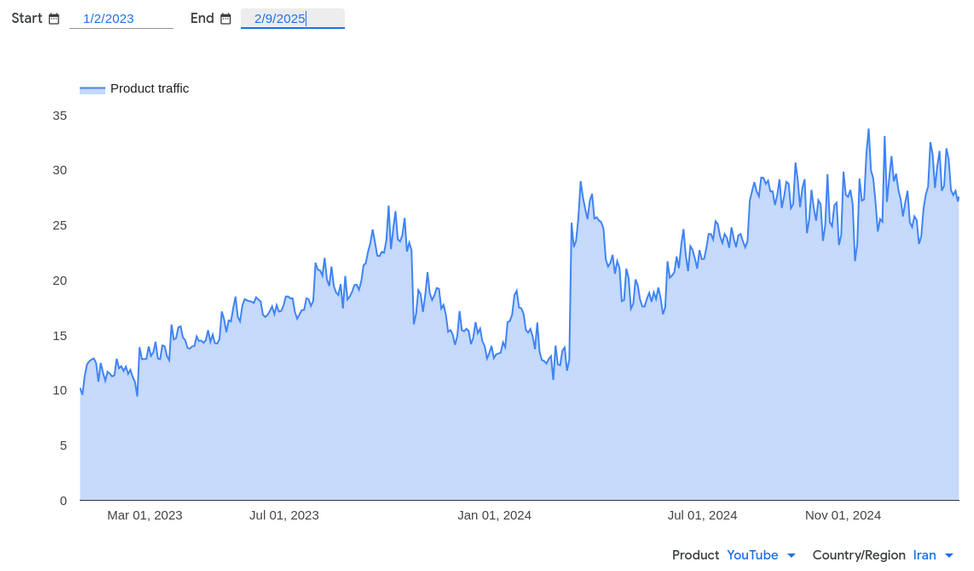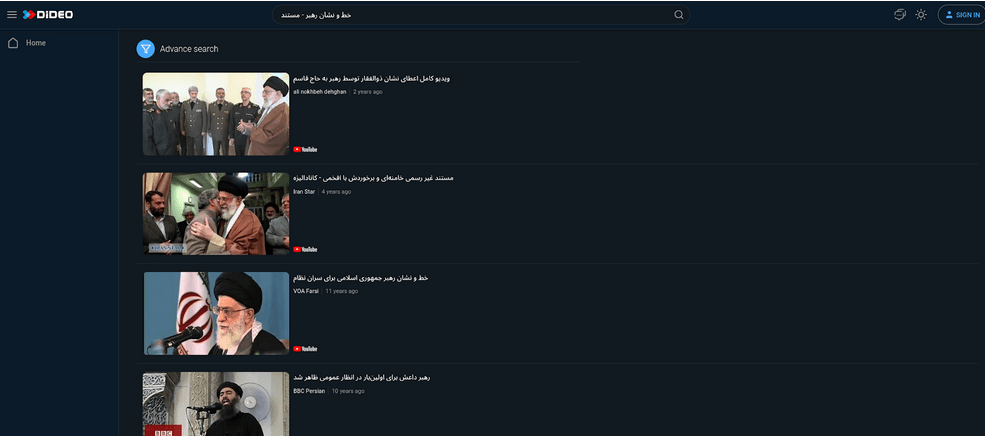This highlights that YouTube has emerged as a central platform for deep and serious discussions about the Islamic Republic, its future, and the regime’s policies. But how do Iranian citizens access YouTube, and what challenges do they face?
YouTube has been officially blocked in Iran since 2006, requiring users to bypass restrictions with VPNs or other tools. Additionally, Iran’s policy of segregating domestic and international internet traffic makes accessing foreign platforms costly and slow. Despite these obstacles, YouTube’s traffic in Iran has grown significantly, reflecting its broad appeal as both a creative outlet and a source of independent information.
According to Google’s Transparency Report, traffic to YouTube from Iran has steadily increased since January 2023. Research by the Iranian Students Polling Agency (ISPA) reveals that 50.4% of public state university students and 8.5% of Iranians over 18 use YouTube. Generation Z leads the way in internet usage, spending three to six hours online daily, primarily seeking social, scientific, technological, and economic news. Persian YouTube content production and viewership have also recovered after a sharp decline in autumn 2022.

From Political Battlegrounds to Diverse Digital Communities
Social media in Iran has undergone a significant transformation in recent years, evolving from an election-focused platform to a hub for daily and continuous discussions. Platforms like Twitter, with around two million Iranian users, remain dominated by radical factions both within and outside the country. In contrast, Instagram, with over 70 million Iranian users, provides a broader view of Iranian society, hosting diverse communities, including pigeon keepers, fortune tellers, gamers, and Gen Z influencers showcasing their lifestyles.
The Iranian government has attempted to create its own social media platforms. For example, Virasty, a Twitter clone, is heavily dominated by radicals loyal to the Islamic Republic. Interestingly, individuals identified as revolutionaries on platforms like Twitter and Clubhouse are labeled reformists on Virasty. Similarly, messaging apps like Eitaa reflect this dynamic, with some jokingly remarking that in Eitaa, Saeed Jalili is perceived as the president. According to a report by the Open Technology Fund (OTF), Eitaa is considered an insecure platform.
While political and social discussions initially gained momentum on Clubhouse in 2021, many serious conversations have since shifted to YouTube. Figures like Mehdi Mahmoudian, a prominent human rights activist, use YouTube to host programs such as Republic’s Crossroads, focusing on political and social issues. These programs often feature sharp critiques of the government and discussions about Iran’s future post-Islamic Republic. Other channels, such as Azad Dialogue, which maintains a cautious tone, and Eco Iran, focusing on economic topics, reflect YouTube’s diversity. Additionally, whistleblowers like Yashar Soltani, who has been repeatedly arrested for exposing government corruption, use YouTube as a platform for discourse.
Meanwhile, Iranian women continue their fight for freedoms, including the right to choose their clothing. Parastoo Ahmadi, for instance, broadcasted a live concert on YouTube that garnered more than two million views. At the start of her concert, she declared: “I am Parastoo, a girl who wants to sing for the people I love. This is a right I could not ignore…” Following this event, she was arrested but later released. Despite having only six videos, her YouTube channel has made a significant impact.
Supporters of the Islamic Republic have also embraced YouTube. Programs like Jedal TV, or Asr TV, support the regime’s regional policies and the so-called “Axis of Resistance.” Other channels, such as Syria News or the Masaf Institute’s channel, run by conspiracy theorist Ali-Akbar Raefipour, disseminate propaganda and conspiracy theories about topics like Satanism, Freemasonry, and Zionism.
YouTube as a Space for Creativity and Freedom
While humor and entertainment remain dominant on YouTube, led by creators like Pooria Potak, Farshad Silent, and Aria Keoxer, the platform now hosts diverse content categories. For many Iranians, YouTube represents a space for creativity, discourse, and monetization, circumventing the limitations of other platforms. Despite higher costs and slower speeds, YouTube’s functionality and reach continue to make it popular.
The economic situation in Iran, where the exchange rate for one dollar is approximately 92,000 Tomans, has driven many creators to seek monetization on YouTube. Some rely on connections outside Iran to access YouTube’s monetization system, while others explore alternative revenue streams like sponsorships and product sales. This financial independence motivates creators to overcome access challenges.
Another major reason for YouTube’s popularity is the quest for freedom of expression. During Hassan Rouhani’s presidency, increased internet access and relaxed restrictions led to a surge in audio-visual content consumption. However, platforms like Video-on-Demand (VOD) services faced heavy censorship under the Iranian Mass Media Regulatory Authority (SATRA), pushing many individuals to create and share content independently on YouTube.
How Google Can Help
Big tech companies, especially Google, can play a pivotal role in helping Iranians gain easier access to YouTube. By implementing measures such as lifting sanctions on Google Cloud through GL-D2 or offering discounts to circumvention tool developers, Google can reduce the cost of accessing these tools. Currently, all incoming traffic from Iran is blocked by Google Cloud, making services hosted on this infrastructure inaccessible in Iran.
Another critical consideration for tech companies is the protection of Iranian users. On [insert date], following the unblocking of WhatsApp and Google Play, the Mehr News Agency revealed the full plan of the Supreme Council of Cyberspace, the highest policymaking body for the internet in Iran. A part of this plan, which mentions the “revised unblocking” of YouTube, states: “The second phase of this program includes 11 measures, covering topics such as providing access to YouTube through ‘governance-compliant platform’…”.
Research by Filterwatch indicates that “governance-compliant platform” refers to creating a copy of YouTube that acts as an intermediary. It would receive user requests, forward them to YouTube, and return responses to users after applying censorship. Russia had previously implemented a similar scheme. For example, https://www.dideo.ir/ been launched. According to its own description, this site uses the YouTube API to act as an intermediary between Iranian users and YouTube. It has the potential to deliver content to Iranian users in a censored format.
Mohammad Farzanepour, one of the founders of this website, explained to Digiato, a tech news platform in Iran, that their system uses AI-based “smart filtering” to comply with the country’s regulations. He acknowledged criticisms on social media regarding censorship but stated that such measures were unavoidable for the platform to operate in Iran.
According to Farzanepour, their AI system, developed in-house, detects and filters specific audio, images, and text that conflict with governing laws. The model continuously learns and improves, automatically blocking flagged content. He added, “If mistakes occur, users report them, and we address them. While we would prefer unrestricted access to YouTube in Iran, we believe partial access is better than none.”
For example, if you search for the phrase “خط و نشان رهبر – مستند” (The Supreme Leader draw a line in the sand – Documentary), the name of a BBC Persian documentary about Ali Khamenei, the Supreme Leader of Iran, examining his political life and governance style, you will not find the video. In contrast, searching the same phrase directly on YouTube lists the documentary as the top result on BBC Persian’s channel.

Access to information is the frontline in the fight against censorship and the Islamic Republic’s control. Policymakers in the EU, the U.S., and big tech companies must adopt strategies that facilitate unrestricted access to information in Iran. By leveraging their resources and collaborating with civil society organizations, these entities can help Iranians reclaim their digital rights and access platforms like YouTube freely, fostering open dialogue and creativity in an increasingly controlled digital environment.
